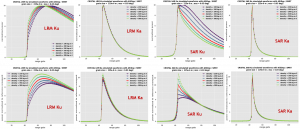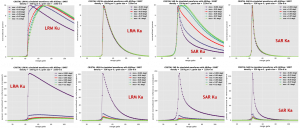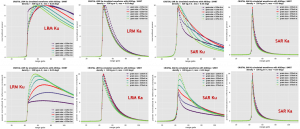A sensitivity analysis was performed, analyzing the impact of snow density, snow grain size and mean square slope in the waveforms shape. This sensitivity analysis was made in CRISTAL configuration: LRM/SAR, Ku & Ka bands. Temperature has a relative small impact on the simulated waveform shape.
Sensitivity analysis: snow density

Sensitivity analysis: snow grain size (values given for grain radius)
Sensitivity analysis: mean square slope

Along with this first analyse, the sensitivity of several level-2 parameters to snow parameters was analyzed. Specifically, the backscattering coefficient, the waveform leading edge width, the pulse peakiness, and the retracking threshold to estimate range at snow/air interface. All the results related to this analyse are available in the dedicated technical note (see section 7.6).
Preliminary conclusions
The sensitivity study performed with different CRISTAL configurations is very instructive and leads to the following main conclusions:
- The three parameters (density, snow grain size and MSS) have a significant influence on the global waveform shapes. In particular on the waveform leading edge, and at the end on the estimated surface elevation. This applies at different degrees in the 4 CRISTAL configurations that have been studied (LRM Ku, LRM Ka, SAR Ku and SAR Ka). It was not really anticipated that the snow/air retracking threshold in Ka band be as sensitive as in Ku band.
- We can anticipate that the different measurement configurations allowed by the CRISTAL dual band altimeter are highly valuable to discriminate snowpack variations. For instance, in these simulations:
- SAR Ka band pulse peakiness parameter is only sensitive to small snow grain size.
- SAR Ku band leading edge width is mainly sensitive to mean square slope
- For all configurations the backscattered energy is high for low mean square slopes values
- It will be really relevant to refine this study with more realistic variations of the different parameters and values coming from in-situ data. This is particularly true for the mean square slope.
- Then, it will also be interesting to refine the reference snowpack, from single-layer to multi-layer as we anticipate that the leading edge and the snow/air interface threshold are sensitive to vertical variations at the snowpack upper part.
- Finally, it would be really relevant to define and develop a physical retracker (based on a physical modeling of the snow pack), accounting for the main impacting parameters that have been discussed previously. For that, studies are needed to:
- further exploit the simulation tool that has been developed,
- define such a family of physical retracker that has never developed before,
- assess how the dual Ku/Ka measurements can discriminate the estimated parameters
